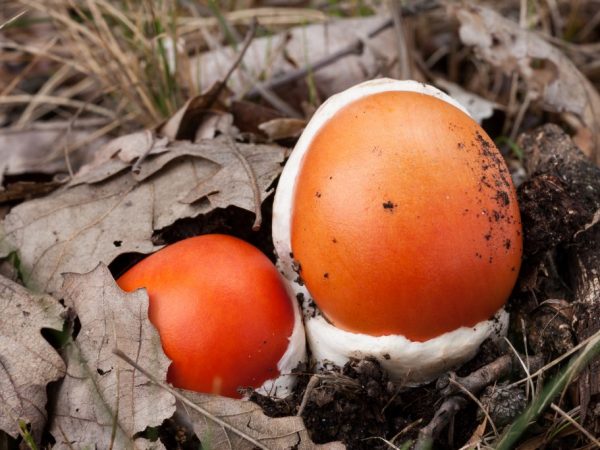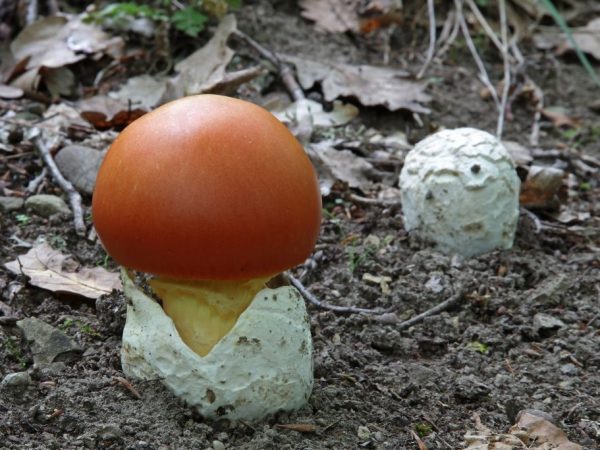Growing and collecting Caesar mushroom
Amanita is a poisonous mushroom, but there are exceptions. For example, the edible Caesar mushroom is a natural miracle with many beneficial properties. Humanity has found application for it in various areas related to nutrition and health, but cooking is the main one.

Growing and collecting Caesar mushroom
The appearance of the mushroom
This mushroom belongs to the Amanite family of the genus Amanita and the species Amanita caesarea. Despite such a formidable family name and the presence of very dangerous relatives, it is edible, belongs to the category of special delicacies, popular even at the feasts of the nobility in the Roman Empire. It is also called "Caesar's amanita", "King's mushroom", "King's amanita", "Caesar's amanita".
In appearance, its fruiting body resembles a typical red fly agaric, especially after rain, when the characteristic white flakes remaining from the general blanket are washed off from the cap of the poisonous fly agaric. The difference between them can be seen in the color of the leg. In the poisonous one, it is white, and in the royal mushroom, it is yellow. White color is inherent only in Volvo, which resembles a broken eggshell.
The color of the cap is both bright red and orange-golden. If the mushroom is already old, then the color of its cap fades. At first it has a hemispherical shape, then it flattens out and becomes slightly convex. The hymenophore is lamellar, yellow or orange.
The fungus begins to develop inside that very white egg-shaped shell, which subsequently encircles its leg. It grows quite large, and the cap has a diameter of up to 20 cm. The club-shaped stem of this mushroom is fleshy and strong, measuring from 5 to 20 cm in height and from 1.5 to 5 cm in diameter. Its flesh is white, but its surface layer is yellowish-orange.
Growing places
Caesarean mushroom grows in many countries, the climate of which is diverse. You can meet him both in the deciduous forests of Transcarpathia and Crimea, and in Africa. They meet him in the Caucasus and America, in such European countries as France, Italy, Germany and Spain. To a greater extent, it is classified as a thermophilic mushroom, since it is widespread in temperate regions and in the Mediterranean subtropics.
Irina Selyutina (Biologist):
The Caesar mushroom on the territory of Russia has never been found in the northern zone. This species prefers light forests and occurs in July-November. It is believed that the average temperature should be about + 20 ℃ and at the same time hold out for 2-3 weeks during the period of its appearance.
For the Caesar mushroom, forms are known that in their color (cap, other structural details) deviate from the main type. In China, a white variety of this species has been discovered for a long time. It is described as a form of Amanita caesaria f. alba (Gillet) E.J. Gilbert, but since, as experts point out, such mushrooms are usually found next to normally colored specimens, the existence of this independent form is called into question.
Doctor of Biological Sciences, Russian mycologist L.N. Vasilyeva (15.02.1950-23.02.2017) described a Far Eastern Caesar mushroom, which she named Amanita caesareoides. Its differences from the main form are as follows:
- Volvo: painted yellow inside; has a special yellow cup (pedunculated volva) 3 cm high in large fruit bodies.
- Hat: there are no scraps of bedspread on the surface (naked), and in the center there is a wide low tubercle.
The fact that the royal mushroom is a valuable organism is proved by its inclusion in the Red Data Books of Ukraine and Germany.
Beneficial features
For the harmonious combination of organic acids and minerals in the composition, the caesar mushroom is called a natural storehouse of vitamins. For every 100 g of mass there are:
- nicotinic acid - 3.607 mg;
- vitamin C - 2.1 mg;
- betaine - 9.4 mg.
Micro and macro elements work as a natural antibiotic against infections and viruses.
Useful mineral compounds of the royal mushroom (per 100 g):
- potassium - 318 mg;
- selenium - 9.3 mg;
- sodium - 5 mg;
- calcium - 3 mg;
- iron - 0.5 mg;
- manganese - 0.047 mg.
Contraindications

The mushroom should not be used for urolithiasis
The use of cesarean mushroom has its own limitations. It should not be consumed by people with urolithiasis and gout. In the latter case, metabolic failure, convulsions, etc. are manifested. For some people, its intolerance is inherent, and when used, they experience vomiting, flatulence, pressure drops and some other phenomena.
Application
With its rich chemical composition, the cesarean mushroom is a godsend for fields such as medicine, pharmacology, cooking and cosmetology. It is difficult to say where his role is more important. These spheres are in many respects contiguous and use the Caesar fly agaric widely.
In cooking
The royal mushroom does not have a characteristic taste and smell. Some, however, hear in it a smell similar to a nut. The Caesar mushroom is considered an exquisite delicacy and is popular among gourmets. Having gained popularity in ancient times, he became an object of praise, and references to him are often found in poems of that time. Since then, the attitude towards him has not changed, and he still attracts chefs. Caesarean mushroom is suitable as an additive to vegetable stews, soups and meat dishes.
It is easy to prepare as it does not require pre-treatment. While the Caesar mushroom has not yet fully grown from its shell-like shell (one might say it is in the egg stage), cooks often add it raw to various salads. The royal mushroom can be fried, baked or simply dried. This is a low-calorie food with an indicator of 22 kcal per 100 g.
Calories per 100 g:
- carbohydrates - 3.26 g;
- proteins - 3.09 g;
- fats - 0.34 g;
- fiber - 1 g;
- 0.85 g of inorganic substances.
In medicine
Because of the individual enzymes it contains, it is credited with having a good preventive ability in the treatment of cancer problems. The fungus reduces the risk of prostate diseases, etc. The drugs created on its basis relieve asthenic syndrome, stabilize cardiovascular activity, normalize stomach functions, stimulate the metabolic process, and put the nervous system in order. Amanita Caesar is especially popular in folk medicine.
Growing methods
Let's face it - the Caesar mushroom does not belong to those fruiting bodies that are popular among fans to grow mushrooms in their summer cottages, since the conditions for this should be close to those in which it grows in the forests. In addition, it takes more than one year to wait until Caesar's fly agaric grows. For a "correct" environment, you need to have trees such as chestnuts, birches, oaks on the site, with mushrooms associated with their roots.
There are several ways to grow it. A sign that the planting has taken root is the white mycelium filaments at the planting site. It is better to use old, overgrown mushrooms for planting.
Landing action plan:
- Bury the crushed fly agarics under the roots of the trees, but not deep.
- Scatter pieces of mushrooms near the desired trees, cover with foliage and water regularly with warm water.
- Transplant fly agarics from the forest.
- Prepare planting material: for this, the mushrooms are crumbled into a bucket, filled with rainwater, after which the bucket is kept at a temperature slightly above 20 ° C for 2 days. Then the contents are poured into a landing site that meets the required conditions.
Conclusion
All the remarkable properties possessed by this species with an unusual name for edible mushrooms "Amanita muscaria" make it an excellent target for mushroom "quiet hunting". With its appearance, which resembles a typical fly agaric, it scares away many mushroom pickers. It is worth studying its description in order to become the owner of one of the treasures that nature has kindly prepared for us.



